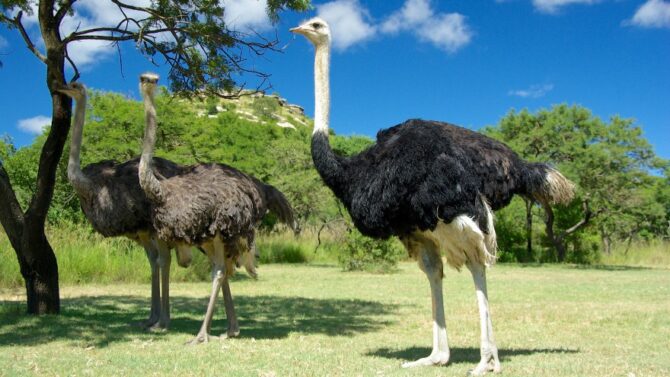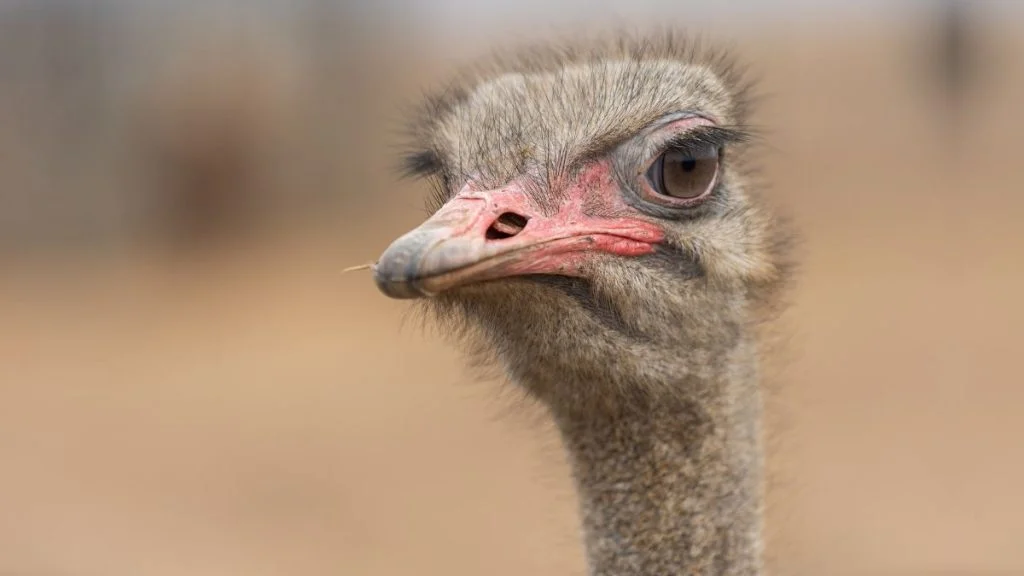Ostriches (Struthio camelus), the popular flightless birds, hold several outstanding records.
They hold the title of the world’s largest, tallest, and heftiest birds, as well as the fastest two-legged animal.
These magnificent birds can run continuously at 30 to 37 mph and sprint up to 43 mph.
Due to their large size and active lifestyle, they have a massive appetite to match.
So, what do ostriches eat, anyway?
Well, these birds are omnivorous, meaning they consume both plants and animals.
Ostriches are also very adaptable eaters. While wild ostriches eat a diverse range of bugs, plants, and small animals, their domesticated counterparts are usually fed a balanced diet similar to the wild ostrich’s diet.
In this article, we’ll take a closer look at the diet and eating habits of these fascinating birds.
How Do Ostriches Eat?
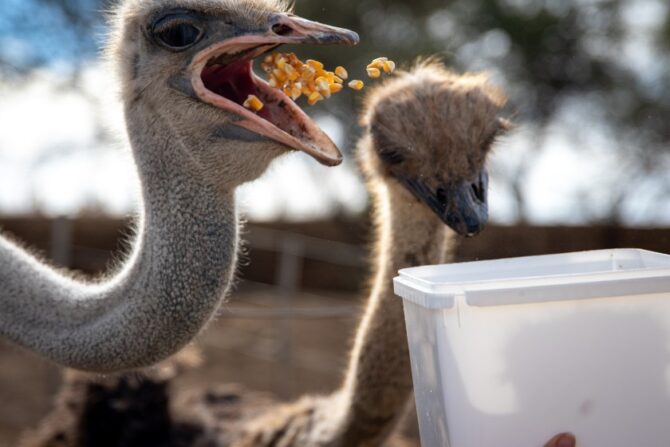
Like all other birds, ostriches eat by swallowing their food whole.
They also have long, tough, and flexible throats, which they often use to break food into small chunks for easy digestion.
Their digestive system consists of two distinct stomachs.
The first stomach is known as the glandular or proventriculus stomach, and it’s similar to our own stomach.
The second stomach is called the gizzard.
Every bird has a gizzard, which grinds its food into fine mucilage for easy digestion.
However, ostriches have very large gizzards and habitually swallow sand and pebbles to help grind their food.1
This unique adaptation equips them to consume different types of fibrous and hard-to-digest plant matter.
What Do Ostriches Eat in the Wild?

Wild ostriches are commonly found in dry, warm savannas and other arid and semi-arid regions throughout Africa.
Ostriches have always been highly nomadic and lived all over Asia and the Arabian Peninsula in ancient times.2
However, their populations have declined since then due to continuous hunting, leaving them primarily in the savannahs and Sahel of Africa.3
The habitat of ostriches usually has a direct impact on their diet.
These awesome-looking birds are quite selective in their food choice, including green grasses, wild leaves and bushes, shrubs, plant roots, plant seeds, flora, sprouts, berries, nuts, rats, snakes, and frogs.
They have a diet made up predominantly of plant matter.
In their natural habitat, ostrich diets consist of about 60% plant material, 20% grains, 15% fruits or legumes, and 5% insects or small-sized animals, salts, and stones.
What Do Ostriches Eat in Zoos and Farms?
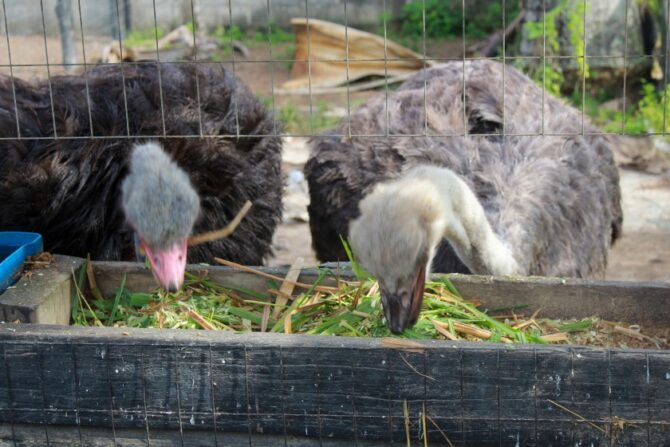
Interestingly, ostriches are reared commercially on every continent except Antarctica.
They are reared for their cosmetic-grade moisturizing oils, meat, and various other derivatives, such as pet feeds, eggshells, and leathers.
When raised for commercial purposes, ostriches are fed with various commercially available feeds, which vary depending on what part of the world they are reared.
Thanks to their adaptive eating habits, they can eat any commercial diet as long as it contains all the vitamins and minerals their bodies need to regenerate during different life stages.
Their typical diet includes fruits or vegetables, living or dried insects, rodents, lizards, amphibians, grit, and sand.
What Plants Do Ostriches Eat?

The world’s tallest and fastest bird on land feeds on plants available to them in their natural surroundings.
These include grasses, flowers, roots, leaves, shrubs, nuts, grains, seeds, berries, and legumes.
Ostriches have a digestive system that can perfectly digest soft and hard flora as long as they consume enough grit and rocks to facilitate digestion in their gizzards.
The Importance of Gizzards in Ostriches
While all birds have gizzards, the gizzards of ostriches are exceptionally large and strong.
As the second stomach in their digestive tract, the ostrich’s gizzard grinds food into a fine paste before moving it into the intestines for further digestion.
Since these birds lack teeth, they rely on their gizzards to digest hard foods, especially as they tend to swallow their food whole.
While eating, ostriches usually swallow sand and stones to grind their food faster.
Remarkably, they have been known to ingest stones as large as about 10 cm!
Do Ostriches Eat Fish?
Although ostriches may eat a fish if offered, they do not forage for fish.
Ostriches are terrestrial, grazing omnivores, and they eat a diverse range of foods with enthusiasm for plants, which form over 50% of their diet.
They rarely come across fish in their surroundings.
Do Ostriches Eat Meat?
Ostriches are omnivores.
So, they’re most likely to consume meat in the form of insects, mammals, lizards, and amphibians, which constitutes about 5% of their diet.
Altogether, the world’s largest birds prefer to eat plants, although they can still eat meat now and then.
What Do Ostriches Eat When They Hatch?

Some birds produce a form of milk known as crop milk to nourish their young, but ostriches are an exception.
When ostrich chicks hatch, they feed on the remainder of the yolk sac collected within their egg into their abdomen.
During the first seven days of their life, they rely on the nutrients from the sac for sustenance while learning how to forage for food from their parents.
After about two weeks, the chicks transition to browsing as their main source to feed.
Farmed or captive chicks, however, are fed with ground food or pellets mixed with small pebbles the size of rice grains.
In the wild, ostrich chicks are known to feed by mimicking the feeding behaviors of their parents.
How Long Can an Ostrich Go without Food?
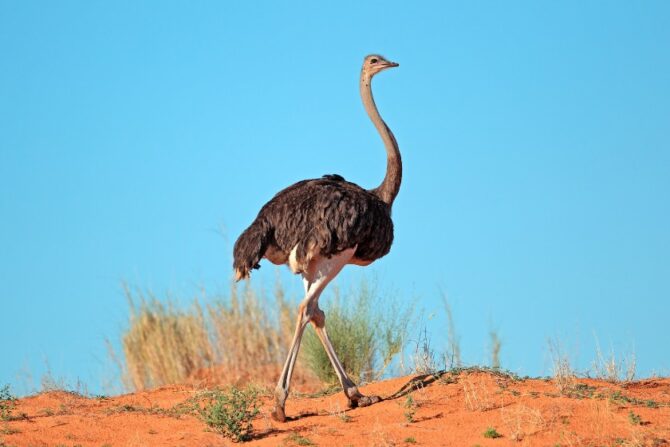
In their natural habitat, ostriches will naturally forage and eat food daily.
These birds are classified as desert birds and can survive in hot and dry regions of the world.
They can also do without water for more than two weeks and can go without food for about two to three days if needed.
Their ability to endure extreme conditions makes them durable birds with exceptional stamina.
These large birds get most of the water they need from their food rather than drinking it directly.
Their ability to run long distances allows them to travel between bountiful feeding grounds, so they’re likely to only go for a short time without eating food.
It is also worth mentioning that they can be radical survivors if forced into a state where they can’t eat.
How Much Does an Ostrich Eat Per Day?
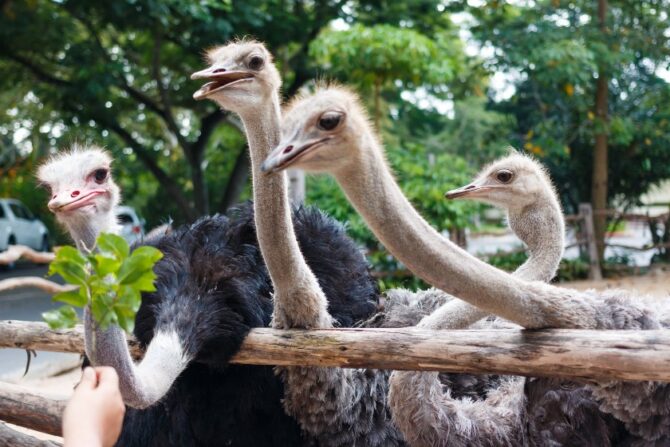
Ostriches kept in captivity are fed between 1.3 kg to 1.8 kg of food daily, comprising any grit or stones necessary to help them digest food in their gizzards.
However, wild ostriches will eat whatever amount of food they need to survive, which depends mostly on their activities at the time.
Their superb ability to run considerable distances guarantees they’re nearly always able to travel between locations with abundant food, which means they can’t go short on food supply.
Frequently Asked Questions (FAQs)
Why Do Ostriches Have Two Stomachs?
The digestive system of ostriches consists of two stomachs because they are needed to metabolize the tough plant fiber the birds eat, which would be impossible if they had just a single stomach as humans do.
What Is an Ostrich’s Favorite Food?
Ostriches prefer eating plants, especially roots, leaves, and seeds, although they occasionally snack on insects, snakes, lizards, or rodents that are within reach.
As an ostrich feeds, food is amassed in the crop above the throat until lumps are large enough to slide down the throat.
What Do I Feed an Ostrich?
Ostriches are very selective and almost predominantly herbivorous.
They relish dicotyledonous plants but will also feed on herbs and grasses.
When accessible, select flowers of Compositae, seed heads of grasses, seed pods of Aloe spp., and acacia flowers and seed pods for their diet.
Wrapping Up
Ostriches are some of the world’s largest consumers, enjoying what the sub-Sahara and savannah offer.
They have a wide-range diet from seeds, nuts, and some mammals they share the terrain with.
The feeding habits of these majestic birds depend on their activity at a particular time.
Fortunately, ostriches can run long distances, which gives them the advantage of having a constant availability of food.
Moreover, conservation efforts have been put in place to checkmate their decreasing population and activities related to the ecosystem.
References & Notes
- Gastroliths. UC Museum of Paleontology
- Ostrich distribution and exploitation in the Arabian peninsula. ResearchGate
- Struthio camelus Linnaeus, 1758. Global Biodiversity Information Facility
